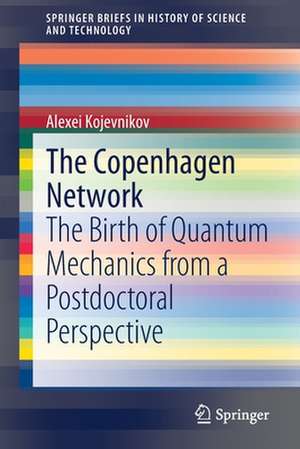The Copenhagen Network: The Birth of Quantum Mechanics from a Postdoctoral Perspective: SpringerBriefs in History of Science and Technology
Autor Alexei Kojevnikoven Limba Engleză Paperback – 3 dec 2020
Din seria SpringerBriefs in History of Science and Technology
- 8%
 Preț: 387.77 lei
Preț: 387.77 lei -
 Preț: 377.18 lei
Preț: 377.18 lei -
 Preț: 443.75 lei
Preț: 443.75 lei -
 Preț: 377.35 lei
Preț: 377.35 lei -
 Preț: 377.35 lei
Preț: 377.35 lei -
 Preț: 378.34 lei
Preț: 378.34 lei -
 Preț: 379.09 lei
Preț: 379.09 lei -
 Preț: 378.54 lei
Preț: 378.54 lei -
 Preț: 378.34 lei
Preț: 378.34 lei -
 Preț: 377.73 lei
Preț: 377.73 lei -
 Preț: 448.21 lei
Preț: 448.21 lei -
 Preț: 377.35 lei
Preț: 377.35 lei -
 Preț: 408.66 lei
Preț: 408.66 lei -
 Preț: 478.33 lei
Preț: 478.33 lei - 20%
 Preț: 296.67 lei
Preț: 296.67 lei -
 Preț: 411.16 lei
Preț: 411.16 lei -
 Preț: 374.30 lei
Preț: 374.30 lei -
 Preț: 489.30 lei
Preț: 489.30 lei -
 Preț: 378.54 lei
Preț: 378.54 lei -
 Preț: 476.57 lei
Preț: 476.57 lei -
 Preț: 378.92 lei
Preț: 378.92 lei - 15%
 Preț: 461.87 lei
Preț: 461.87 lei -
 Preț: 442.83 lei
Preț: 442.83 lei -
 Preț: 446.08 lei
Preț: 446.08 lei -
 Preț: 379.48 lei
Preț: 379.48 lei -
 Preț: 379.86 lei
Preț: 379.86 lei -
 Preț: 344.53 lei
Preț: 344.53 lei -
 Preț: 378.92 lei
Preț: 378.92 lei -
 Preț: 376.04 lei
Preț: 376.04 lei -
 Preț: 347.41 lei
Preț: 347.41 lei -
 Preț: 324.70 lei
Preț: 324.70 lei -
 Preț: 377.35 lei
Preț: 377.35 lei -
 Preț: 444.35 lei
Preț: 444.35 lei
Preț: 379.09 lei
Nou
Puncte Express: 569
Preț estimativ în valută:
72.56€ • 75.46$ • 60.80£
72.56€ • 75.46$ • 60.80£
Carte tipărită la comandă
Livrare economică 13-27 martie
Preluare comenzi: 021 569.72.76
Specificații
ISBN-13: 9783030591878
ISBN-10: 3030591875
Pagini: 126
Ilustrații: XI, 126 p. 10 illus.
Dimensiuni: 155 x 235 mm
Greutate: 0.2 kg
Ediția:1st ed. 2020
Editura: Springer International Publishing
Colecția Springer
Seria SpringerBriefs in History of Science and Technology
Locul publicării:Cham, Switzerland
ISBN-10: 3030591875
Pagini: 126
Ilustrații: XI, 126 p. 10 illus.
Dimensiuni: 155 x 235 mm
Greutate: 0.2 kg
Ediția:1st ed. 2020
Editura: Springer International Publishing
Colecția Springer
Seria SpringerBriefs in History of Science and Technology
Locul publicării:Cham, Switzerland
Cuprins
Chapter 1 - Introduction.- Chapter 2 - Scandinavian Settings.- Chapter 3 - International Networking.-Chapter 4 - A “Kuhnian” Crisis.- Chapter 5 - Revolt of the Postdoc.- Chapter 6 - Philosophical Wrangling.- Chapter 7 - Conclusions and the Forman Thesisum.
Notă biografică
Alexei Kojevnikov received his Ph.D. in History of Science from the Institute for History of Science and Technology in Moscow. After a Humboldt fellowship in Germany and several postdoctoral and faculty positions in the USA, he teaches History of Science at the University of British Columbia, Vancouver, Canada. His research focuses on the history and social relations of modern physics, combining it with approaches from cultural history. He authored Stalin’s Great Science: The Times and Adventures of Soviet Physicists (London, 2004) and Rockefeller Philanthropies and Soviet Science (St. Petersburg, 1993) and edited Science in Russian Context (a special issue of Science in Context, 2002). He is also a Co-Editor of Weimar Culture and Quantum Mechanics (Singapore, 2011), Intelligentsia Science: The Russian Century, 1860-1960 (Chicago, 2008), and Paul Dirac and Physics of the 20th Century (Moscow, 1990).
Caracteristici
Describes the first faltering steps of early quantum physicists Follows the trajectories of young researchers in economically uncertain and difficult times Is a part of a four-volume collection tracing the development of quantum theory at four European centres
